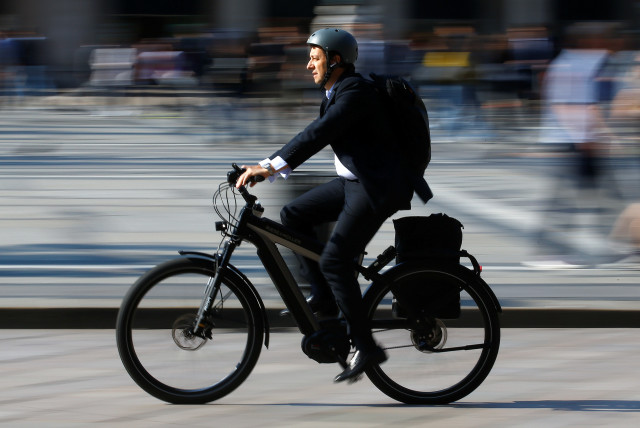E-scooter and e-bike casualties on the rise in Israel

The number of people killed or injured in e-scooter accidents in Israel jumped by a staggering 440% from 2018 to 2022. Meanwhile, the train system is struggling to recover its pre-pandemic levels.
There has been a staggering rise in casualties from electric scooters and electric bicycles in Israel in recent years, according to new data supplied to The Media Line by Israel’s Central Bureau of Statistics (CBS). Meanwhile, other figures show that train usage in Israel is still struggling to recover after plummeting during the COVID pandemic and that the number of cars on Israeli roads continues to rise.
According to data reported to police, combined with unreported hospital data, there were 1,546 casualties from e-scooter accidents in 2022, with five people killed and 1,541 injured. This was 15.81% higher than in 2021, when there were 1,335 casualties, and a huge 440% higher than in 2018, when there were 286 casualties.
E-bike casualties, by contrast, decreased slightly in 2022 but the number of casualties was significantly higher than for e-scooters. There were 2,247 casualties from e-bikes in 2022—13 fatalities and 2,234 injuries—compared with 2,287 casualties in 2021—13 fatalities and 2,274 injuries—a fall in total casualties of 1.71%. However, the 2021 figures were 16.57% higher than in the previous year, with 1,962 e-bike casualties in 2020.
Data on sale numbers of e-scooters and e-bikes was not available from the CBS or from private companies contacted by The Media Line.
“From what I see in the data, the e-scooter numbers are going up even more than the e-bikes. It’s getting worse and worse,” said Malky Ben-David, who works with the Road Safety Department at the CBS.
COVID's transportation impact
Ben-David said a lack of training and education was contributing to the trend.
“We see so many people not with helmets riding wherever they want,” Ben-David said. “You’re supposed to be 16, [but] plenty of kids are getting on these, and it’s just so dangerous.”
An employee identified only as Avi, who works at the Sporteka e-bike and e-scooter shop in Jerusalem, said he had seen many e-scooter accidents and had dozens of the vehicles waiting to be repaired.
“It [the e-scooter] is more dangerous than the electric bike,” Avi said. “The bike has more stability.”
Avi said e-scooter sales were highest over the summer and would taper off in the winter.
Meanwhile, as the Israeli summer reaches its peak, along with more bikes and scooters on the roads, there are more cars as well.
The CBS data shows that train usage dropped sharply when the pandemic began and has not returned to its pre-pandemic peak. In 2019, before COVID, 69 million train trips were recorded in Israel. In 2020, that number plummeted to 24 million. In 2021, the number rose to 35 million, and in 2022 to under 55 million.
“Some people left public transportation in favor of cars because, during COVID, public transportation was limited,” said Yael Klejman, head of the Transport and Communication Sector at the CBS.
At the same time, the number of car registrations has risen. In 2019, there were about 254,000 new car registrations. In 2020, this dipped to around 217,000. In 2021, the number of new registrations shot up to around 290,000. And in 2022, there were about 266,000.
“Some people went to buy cars or even to buy secondhand cars, and the market for secondhand cars was very hot,” Klejman said. “The prices and the values of the cars usually go down with the years, [but recently] they even stayed the same. It was a hot market.”
The increase in the number of cars on the roads—obvious to anyone stuck in the ever-growing traffic jams around Israel—creates a higher risk for those using bikes or scooters.
Jerusalem resident Yair Asch rides his e-bike often and said he relies on it despite the risks.
“I think that the government should do more to make us bike riders feel safe,” he said. “I’m all for the urbanization of Jerusalem, especially the areas where I live and I go to school. They should be more for bikes and pedestrians walking, and not for cars and buses.”
To avoid further increases in e-scooter and e-bike accidents, Ben-David recommended better education for both riders and pedestrians.
“Everybody needs to be familiar with where they’re supposed to be,” Ben-David said. “Whether it’s a vehicle in the right lane or an e-bike or an e-scooter in their designated lane or a pedestrian walking in the right place … we publish in every press release that crosswalks are not a safe place. There are so many accidents in the crosswalks.”
Klejman suggested the “three E’s: enforcement, engineering, and education.” She said enforcement would ensure that riders stayed in their designated lanes and wore proper safety equipment, engineering would ensure that proper infrastructure was in place for riders and pedestrians, and education would remind everyone to obey traffic laws to keep the roads safer.
“We have to look out for each other, pay attention to the numbers, and stay safe,” Ben-David said.
Asch agreed that everyone had a responsibility for road safety, not just car drivers.
“I also know that a lot of bike-riding people drive without any care,” Asch said. “And they can always go and hit a pedestrian and people that are just standing on the sidewalk. And it’s our responsibility to drive carefully also.”
Patrick Doyle is a recent graduate of San Diego State University and an intern in The Media Line’s Press and Policy Student Program.
Jerusalem Post Store
`; document.getElementById("linkPremium").innerHTML = cont; var divWithLink = document.getElementById("premium-link"); if (divWithLink !== null && divWithLink !== 'undefined') { divWithLink.style.border = "solid 1px #cb0f3e"; divWithLink.style.textAlign = "center"; divWithLink.style.marginBottom = "15px"; divWithLink.style.marginTop = "15px"; divWithLink.style.width = "100%"; divWithLink.style.backgroundColor = "#122952"; divWithLink.style.color = "#ffffff"; divWithLink.style.lineHeight = "1.5"; } } (function (v, i) { });

